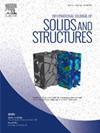OXFORD-UMAT: An efficient and versatile crystal plasticity framework
IF 3.4
3区 工程技术
Q1 MECHANICS
International Journal of Solids and Structures
Pub Date : 2024-11-01
DOI:10.1016/j.ijsolstr.2024.113110
引用次数: 0
Abstract
The crystal plasticity-based finite element method is widely used, as it allows complex microstructures to be simulated and allows direct comparison with experiments. This paper presents the OXFORD-UMAT for Abaqus®, a novel crystal plasticity code that is publicly available online for researchers interested in using crystal plasticity. The model is able to simulate a wide range of materials and incorporates two different solvers based on the solution of slip increments and Cauchy stress, with variants of state update procedures including explicit, semi-implicit, and fully-implicit for computational efficiency that can be set by the user. Constitutive laws are available for a range of materials with single or multiple phases for slip, creep, strain hardening, and back stress. The model includes geometrically necessary dislocations that can be computed using finite element interpolation functions by four alternative methods, including the total form with and without a correction for the dislocation flux, a widely used rate form, and a slip-gradient formulation. In addition, the initial strengthening and subsequent softening seen in irradiated materials can also be simulated with the model. The analysis is available in 2D (plane stress and plane strain) and 3D, including linear and quadratic elements. Here we include full derivations of the key equations used in the code and then demonstrate the capability of the code by modeling single-crystal and large-scale polycrystal cases. Comparison of OXFORD-UMAT with other available crystal plasticity codes for Abaqus® reveals the efficiency of the proposed approach, with the backup solver offering greater versatility for handling convergence issues commonly found in practical applications.
OXFORD-UMAT:高效多用途晶体塑性框架
基于晶体塑性的有限元方法可以模拟复杂的微结构,并能与实验进行直接比较,因此被广泛使用。本文介绍了适用于 Abaqus® 的 OXFORD-UMAT 模型,这是一种新型晶体塑性代码,可在线公开,供有兴趣使用晶体塑性的研究人员使用。该模型能够模拟多种材料,并结合了基于滑移增量和考奇应力求解的两种不同求解器,其状态更新程序包括显式、半隐式和全隐式,计算效率可由用户设置。对于滑移、蠕变、应变硬化和背应力的单相或多相材料,可提供各种构造定律。该模型包括几何上必要的位错,可通过四种方法使用有限元插值函数进行计算,包括有位错通量校正和无位错通量校正的总形式、广泛使用的速率形式和滑移梯度形式。此外,该模型还能模拟辐照材料的初始强化和随后的软化。该分析可用于二维(平面应力和平面应变)和三维,包括线性和二次元元素。在此,我们将对代码中使用的关键方程进行全面推导,然后通过对单晶和大规模多晶体进行建模来展示代码的能力。将 OXFORD-UMAT 与其他可用的 Abaqus® 晶体塑性代码进行比较后,我们发现所提议的方法非常高效,其备份求解器在处理实际应用中常见的收敛问题方面具有更高的通用性。
本文章由计算机程序翻译,如有差异,请以英文原文为准。
求助全文
约1分钟内获得全文
求助全文
来源期刊
CiteScore
6.70
自引率
8.30%
发文量
405
审稿时长
70 days
期刊介绍:
The International Journal of Solids and Structures has as its objective the publication and dissemination of original research in Mechanics of Solids and Structures as a field of Applied Science and Engineering. It fosters thus the exchange of ideas among workers in different parts of the world and also among workers who emphasize different aspects of the foundations and applications of the field.
Standing as it does at the cross-roads of Materials Science, Life Sciences, Mathematics, Physics and Engineering Design, the Mechanics of Solids and Structures is experiencing considerable growth as a result of recent technological advances. The Journal, by providing an international medium of communication, is encouraging this growth and is encompassing all aspects of the field from the more classical problems of structural analysis to mechanics of solids continually interacting with other media and including fracture, flow, wave propagation, heat transfer, thermal effects in solids, optimum design methods, model analysis, structural topology and numerical techniques. Interest extends to both inorganic and organic solids and structures.

 求助内容:
求助内容: 应助结果提醒方式:
应助结果提醒方式:


